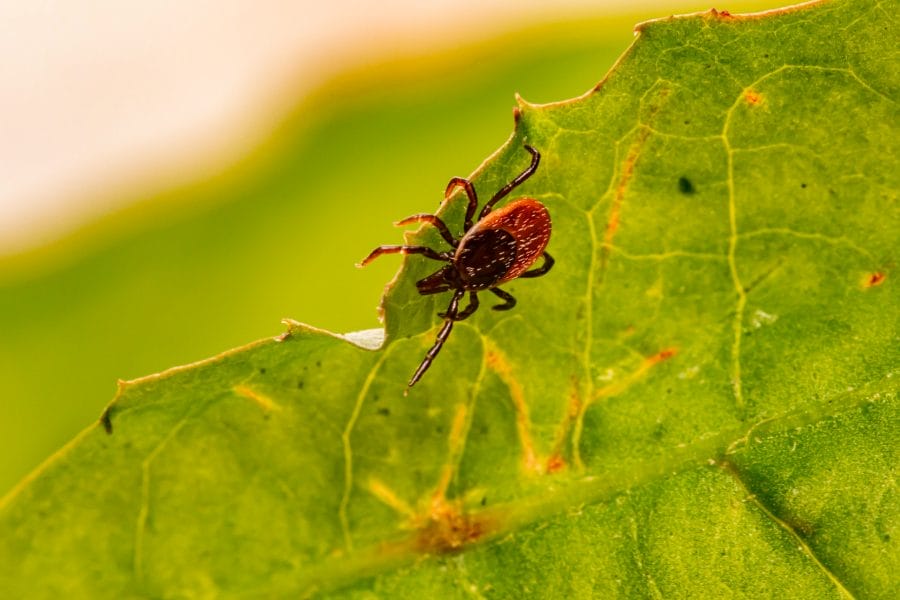The tick is an enemy of hikers! So, with the increase in the number of people infected with Lyme disease in Europe, in this post, we outline how to protect yourself from ticks while hiking!
What is a tick?
Ticks are small mite arachnids that feed on the blood of animals – especially mammals.
They vary in size from the size of a poppy seed to that of a pea, depending on the stage of their life cycle and waterlogging.
Although tick bites are generally harmless, unfortunately they are also capable of transmitting diseases to humans, some of which can be extremely disabling and life threatening.

What diseases can ticks transmit?
A tick bite can transmit the following diseases:
1. Lyme disease
This is caused by the bacteria Borrelia Burgdorferi, and is transmitted by infected ticks in Europe and North America.
The classic symptom of Lyme disease is a skin lesion that manifests as a red ring of inflammation that gradually spreads over the skin, 1 to 4 weeks after the bite.
Watch out for other symptoms that may appear: fatigue, flu-like symptoms, headache, muscle or joint pain, or swollen lymph nodes.
If the disease progresses it can cause: arthritis, nervous problems, facial paralysis, meningitis with fever, severe headaches, memory problems and sometimes irregular heartbeats.
2. Babesiosis
Caused by the Babesia parasite, similar to the malaria parasite, this organism attacks red blood cells and requires laboratory identification to diagnose the infection.
The most common symptoms are fever and anemia, as well as fatigue and loss of appetite. They usually develop 1 to 4 weeks after the tick bite.
3. Ehrlichiosis
It is a bacterial infection that attacks white blood cells.
Symptoms can appear 1 to 2 weeks after the bite: fever, headache, fatigue, muscle pain, nausea, vomiting and, in some cases, rash.
4. Encephalitis
It is a serious viral infection that can affect the central nervous system or the brain.
Ticks carrying the disease live in rural or forest areas in parts of Europe from late spring to early autumn.
The first symptoms include a flu-like syndrome and a fever 1 to 2 weeks after being bitten. If the disease progresses, it causes severe headaches, photophobia, and signs of meningitis such as delirium or paralysis.
Also read our post: How To Treat Hiking Injuries: A Hillwalk Guide
How to protect yourself from ticks while hiking?
Prevention is better than cure! Take the necessary measures to protect yourself from ticks while hiking:
- Walk in the middle of the trails and avoid walking through thick vegetation or tall grass
- Avoid swampy areas
- Cover your limbs – with pants, socks, long sleeves
- Use insect repellant. DEET products are the most effective but also the most toxic. Apply the repellent to your clothes rather than your skin.
- Brush your clothes before going home. Remember that some ticks are no bigger than a pinhead.

How to safely remove a tick?
The longer a tick stays to feed, the higher the risk of infection. It is therefore important to eliminate it quickly and correctly.
Be careful when removing the tick, because a stressed tick regurgitates in the blood, thus increasing the risk of infection! Do not use fire, do not try to freeze the tick, do not try to suffocate it with ointment or oil.
The best solution is to use a clamp for ticks. There are many types available in pharmacies or online. Read the instructions to use it correctly.
If you decide to use tweezers, grab the tick as close to the skin as possible and pull it steadily upward until it is fully removed. Be careful not to twist the tick, as its mandibles may become embedded in the skin.
After removing the tick, wash the skin with warm soapy water and use an antiseptic.
Make sure you have it all removed and watch out for symptoms of infection.


